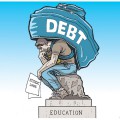 Is the United States economy spinning out of control? Is the dollar in danger of a collapse? The key is in comparison, according to Capital Economics analyst Paul Ashworth.
Is the United States economy spinning out of control? Is the dollar in danger of a collapse? The key is in comparison, according to Capital Economics analyst Paul Ashworth.
The chief economist for the U.S. division of the company reported that although Capital Economics figures for the U.S. appeared dour, a global perspective shows that both the dollar and the international presence of the U.S. are still on firm ground.
The latest U.S. Economics Focus from the company shows the U.S. GDP at around $15 trillion, while national debt has tripled from 2001 to 2011 to $16.8 trillion, a dire imbalance that hints at an overwhelming debt cycle.
Ashworth debunked that theory by pointing out the real net worth of the U.S. economy, including total domestic assets and liabilities, is about 550 percent of the GDP, far beyond the current debt levels. When the rise in domestic asset value is accounted for, the rise in credit market debt and other liabilities does not paint so painful a picture.
The economist also reminded investors that the majority of Treasuries outstanding was still held by the Federal Reserve (around 16 percent of all government debt, according to the report), and although China was the highest international holder (at 11 percent), the country still came in a distant second to the United States’ own banks.
The picture also grows more positive when national debt benchmarks are examined. According to Ashworth, net external liabilities are around 30 percent of U.S. GDP, a modest amount compared to the debts of other nations. With the global perspective, a future collapse in the U.S. dollar or an increase in interest rates still appears highly unlikely.
This perspective ties in well with similar Capital Economics reports provided in the past month, all tying into domestic job growth and the continued rise of economic opportunity in America. A March 25 weekly post focused on “sustainable domestic forces,” comparing the stability of the U.S. position with worsening troubles in areas like Cyprus. Meanwhile, a March 20 U.S. Chart Book from the company predicted that first-quarter real consumption growth would grow by 2 percent in the first quarter of 2013 thanks to rising orders and subsequent domestic production. The Chart Book cited future fiscal policy — along with the growing issues of the Eurozone crisis — as key threats for the rest of 2013.
[cf]skyword_tracking_tag[/cf]






No Comment